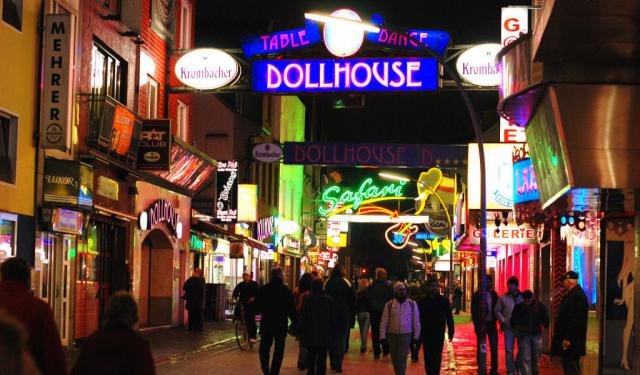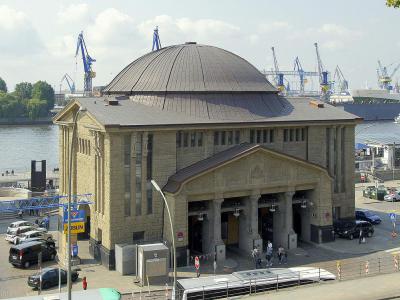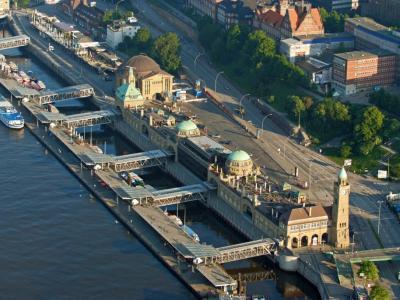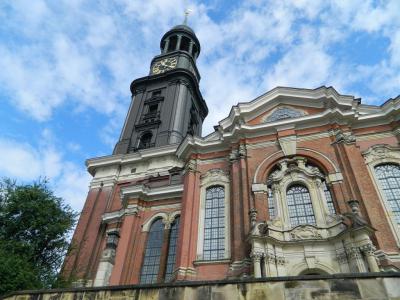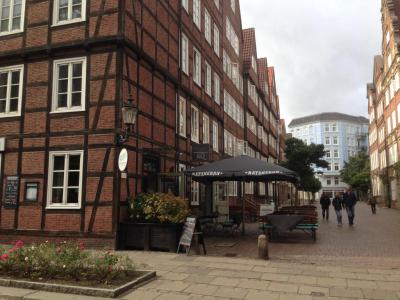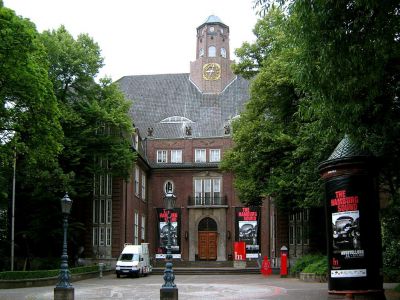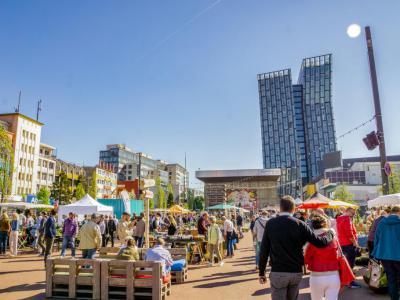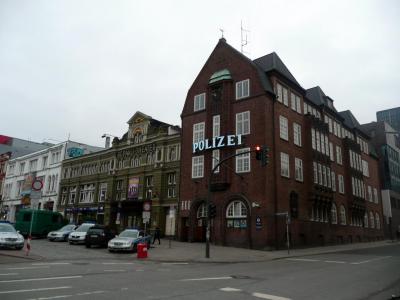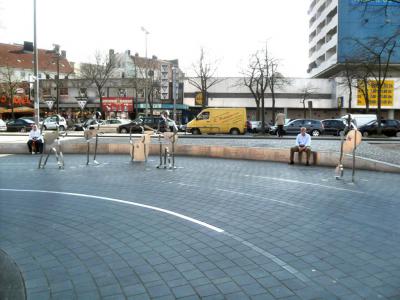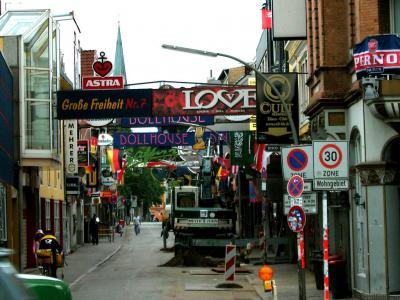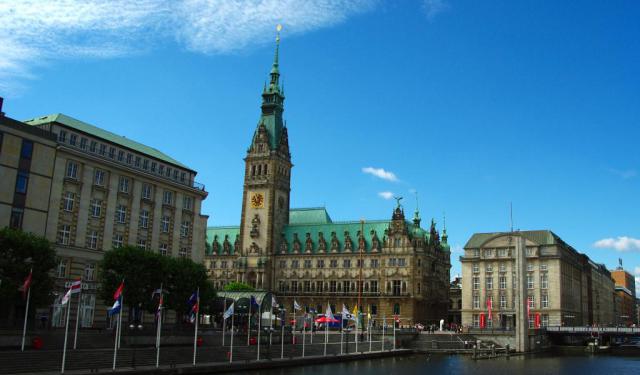St. Pauli and Red-light District Walking Tour (Self Guided), Hamburg
St. Pauli is a vibrant quarter in Hamburg. It is home to museums, churches, waterfront buildings, and the famous Red Light District. During the 19th century, many sailors would arrive in Hamburg's busy port and immediately look for ways to spend their wages. St. Pauli obliged with entertainment, bars, and strip clubs. Today, the entertainment tradition continues.
The Old Elbe Tunnel is a must-see engineering marvel. The tunnel runs underneath the Elbe River and is open 24/7 to pedestrians. Walk to the other side and enjoy a view of the port.
St. Pauli Piers gives visitors the chance to enjoy the historic waterfront. Visitors can walk the promenade and enjoy cafes, restaurants, and bars.
St. Michaelis Church is the largest church in Hamburg and boasts impressive architecture. The church features a marble pulpit, baptismal font, and altar. Don't miss the view from the observation platform at the top of the church's tower.
The Composers Quarter features six museums dedicated to six influential composers with Hamburg ties. In addition, visitors can learn about Hamburg's extensive history at the Museum for Hamburg History.
Rope Street was named after the ropes that were crafted on the street. Today, it is a vibrant street filled with art galleries, restaurants, bars, nightclubs, and strip clubs.
Playing Booths Square used to host artists and jugglers and today features different markets, festivals, and events. For example, check out the weekly St. Pauli Night Market or the Santa Pauli Christmas Market.
The distinctive David Watch Police Station has been featured in numerous TV shows and famously incarcerated Paul McCartney and Pete Best.
Beatles Square celebrates The Beatles Hamburg connection. The band got its start in Hamburg, and the square features statues of band members.
Take the St. Pauli and Red Light District walking tour and experience the history and liveliness of this vibrant area.
The Old Elbe Tunnel is a must-see engineering marvel. The tunnel runs underneath the Elbe River and is open 24/7 to pedestrians. Walk to the other side and enjoy a view of the port.
St. Pauli Piers gives visitors the chance to enjoy the historic waterfront. Visitors can walk the promenade and enjoy cafes, restaurants, and bars.
St. Michaelis Church is the largest church in Hamburg and boasts impressive architecture. The church features a marble pulpit, baptismal font, and altar. Don't miss the view from the observation platform at the top of the church's tower.
The Composers Quarter features six museums dedicated to six influential composers with Hamburg ties. In addition, visitors can learn about Hamburg's extensive history at the Museum for Hamburg History.
Rope Street was named after the ropes that were crafted on the street. Today, it is a vibrant street filled with art galleries, restaurants, bars, nightclubs, and strip clubs.
Playing Booths Square used to host artists and jugglers and today features different markets, festivals, and events. For example, check out the weekly St. Pauli Night Market or the Santa Pauli Christmas Market.
The distinctive David Watch Police Station has been featured in numerous TV shows and famously incarcerated Paul McCartney and Pete Best.
Beatles Square celebrates The Beatles Hamburg connection. The band got its start in Hamburg, and the square features statues of band members.
Take the St. Pauli and Red Light District walking tour and experience the history and liveliness of this vibrant area.
How it works: Download the app "GPSmyCity: Walks in 1K+ Cities" from Apple App Store or Google Play Store to your mobile phone or tablet. The app turns your mobile device into a personal tour guide and its built-in GPS navigation functions guide you from one tour stop to next. The app works offline, so no data plan is needed when traveling abroad.
St. Pauli and Red-light District Walking Tour Map
Guide Name: St. Pauli and Red-light District Walking Tour
Guide Location: Germany » Hamburg (See other walking tours in Hamburg)
Guide Type: Self-guided Walking Tour (Sightseeing)
# of Attractions: 11
Tour Duration: 2 Hour(s)
Travel Distance: 3.4 Km or 2.1 Miles
Author: Gloria
Sight(s) Featured in This Guide:
Guide Location: Germany » Hamburg (See other walking tours in Hamburg)
Guide Type: Self-guided Walking Tour (Sightseeing)
# of Attractions: 11
Tour Duration: 2 Hour(s)
Travel Distance: 3.4 Km or 2.1 Miles
Author: Gloria
Sight(s) Featured in This Guide:
- Old Elb Tunnel
- St. Pauli Piers
- St. Michaelis Church
- Composers Quarter
- Museum for Hamburg History
- Reeperbahn (Rope Street)
- Spielbudenplatz (Playing Booths Square)
- Davidwache (David Watch Police Station)
- Herbertstraße (Herbert Street)
- Beatles-Platz (Beatles Square)
- Große Freiheit (Great Freedom Street)
1) Old Elb Tunnel (must see)
The Old Elb Tunnel first opened in 1911. The 426-meter-long (1,398 foot) tunnel runs 24 meters (80 feet) underneath the river's surface. It was the first river tunnel on the continent.
The Old Elb Tunnel is open to vehicle traffic and pedestrians and connects central Hamburg with the docks and shipyards on the River Elbe's south side.
When the tunnel opened in 1911, it was a scientific marvel. Moreover, it considerably improved daily life for the tens of thousands of workers who could cross the river and reach their workplaces much more efficiently.
The tunnel is under the water table of the Elbe River, and work was completed under pressure to keep water from flooding the construction.
The tunnel is open 24/7 for pedestrians and bicycles and is open during the day for vehicle traffic. Six lifts carry pedestrians and vehicles to the tunnel.
The tunnel hosts an art exhibition. In addition, the Elbtunnel-Marathon takes place on the tunnel. Visitors can admire the original walls, which are decorated and display river themes such as fish and crabs.
Why You Should Visit:
The Old Elbe Tunnel represents a feat of engineering. It's free to pedestrians and provides an exciting look at the tunnel's architecture.
Tips:
After crossing the tunnel, visitors can enjoy views of the Elbe River and the harbor.
The Old Elb Tunnel is open to vehicle traffic and pedestrians and connects central Hamburg with the docks and shipyards on the River Elbe's south side.
When the tunnel opened in 1911, it was a scientific marvel. Moreover, it considerably improved daily life for the tens of thousands of workers who could cross the river and reach their workplaces much more efficiently.
The tunnel is under the water table of the Elbe River, and work was completed under pressure to keep water from flooding the construction.
The tunnel is open 24/7 for pedestrians and bicycles and is open during the day for vehicle traffic. Six lifts carry pedestrians and vehicles to the tunnel.
The tunnel hosts an art exhibition. In addition, the Elbtunnel-Marathon takes place on the tunnel. Visitors can admire the original walls, which are decorated and display river themes such as fish and crabs.
Why You Should Visit:
The Old Elbe Tunnel represents a feat of engineering. It's free to pedestrians and provides an exciting look at the tunnel's architecture.
Tips:
After crossing the tunnel, visitors can enjoy views of the Elbe River and the harbor.
2) St. Pauli Piers (must see)
Saint Pauli Piers offers historic waterfront buildings and stunning views. The first pier was built in 1839 and served as a steamship terminal. The piers now connect more modern transportation options. The current floating piers were originally built in 1907 and rebuilt in the 1950s after World War II bombs damaged them.
The floating jetty is 700 meters (2297 feet) long. This vibrant waterfront area draws visitors to see the busy harbor upfront, take pictures, and enjoy the scenery. The piers are connected to the city by ten movable bridges. Hop on a ferry or catamaran and take a tour of the harbor. If you have tickets to The Lion King, you can get ferry transport to the production's musical island.
The 205-meter-long (672-foot) terminal building features two distinct green domes. On the attractive Saint Pauli Piers promenade, visitors can find restaurants, cafes, and bars along the piers. Visitors can also enter the Old Elbe tunnel from the piers.
The floating jetty is 700 meters (2297 feet) long. This vibrant waterfront area draws visitors to see the busy harbor upfront, take pictures, and enjoy the scenery. The piers are connected to the city by ten movable bridges. Hop on a ferry or catamaran and take a tour of the harbor. If you have tickets to The Lion King, you can get ferry transport to the production's musical island.
The 205-meter-long (672-foot) terminal building features two distinct green domes. On the attractive Saint Pauli Piers promenade, visitors can find restaurants, cafes, and bars along the piers. Visitors can also enter the Old Elbe tunnel from the piers.
3) St. Michaelis Church (must see)
Saint Michaelis Church is one of Hamburg's five main Lutheran churches. This important landmark church is a gorgeous example of baroque architecture. Most of Hamburg's churches were built as Roman Catholic Churches and then converted to Protestant churches; however, Saint Michaelis is one of Hamburg's few purpose-built Protestant churches.
The church is dedicated to the Archangel Michael, and a large bronze statue representing Saint Michael stands above the church's portal. The impressive baroque clock tower is 132 meters tall (433 feet). The clock tower is covered in copper and serves as a landmark for ships entering the Elbe River.
A church has stood on this site since 1647. The current Saint Michaelis Church was built in 1786. Saint Michaelis underwent reconstruction after a 1906 fire, and after WWII bombs damaged it.
Johannes Brahms, the famous composer and pianist, was baptized in Saint Michaelis in 1833.
Saint Michaelis is the largest church in Hamburg and can seat 2.500. The marble pulpit features an impressive staircase. The white marble baptismal font represents a seashell. The marble altar is 20 meters (65 feet) tall and features three scenes from the life of Jesus.
The large crypt has over 2,000 grave chambers. The crypt was used as a shelter during WWII and is now used for concerts and church services.
Visitors can access the 106-meter-tall (348 foot) observational platform using the elevator or stairs. The view from the top is spectacular.
The church is dedicated to the Archangel Michael, and a large bronze statue representing Saint Michael stands above the church's portal. The impressive baroque clock tower is 132 meters tall (433 feet). The clock tower is covered in copper and serves as a landmark for ships entering the Elbe River.
A church has stood on this site since 1647. The current Saint Michaelis Church was built in 1786. Saint Michaelis underwent reconstruction after a 1906 fire, and after WWII bombs damaged it.
Johannes Brahms, the famous composer and pianist, was baptized in Saint Michaelis in 1833.
Saint Michaelis is the largest church in Hamburg and can seat 2.500. The marble pulpit features an impressive staircase. The white marble baptismal font represents a seashell. The marble altar is 20 meters (65 feet) tall and features three scenes from the life of Jesus.
The large crypt has over 2,000 grave chambers. The crypt was used as a shelter during WWII and is now used for concerts and church services.
Visitors can access the 106-meter-tall (348 foot) observational platform using the elevator or stairs. The view from the top is spectacular.
4) Composers Quarter
The Composers Quarter features six museums dedicated to composers. Hamburg has always celebrated its musical traditions and history and has been home to several influential composers, such as Johanne Brahms.
Today, visitors can immerse themselves in the lives and works of six local composers. These museums are located in restored buildings. The museums include the Brahms Museum, the Telemann Museum, the Carl Phillip Emanuel Bach Museum, the Johann Adolph Hasse Museum, the Gustav Mahler Museum, and the Fanny & Felix Mendelssohn Museum.
The Brahms Museum is dedicated to the well-known and influential composer Johannes Brahms. The museum is housed in a restored 1751 merchant's house. The house where Brahms was born was located nearby but destroyed during World War II.
Brahms lived in Hamburg until he moved to Vienna at the age of 29. The museum focuses on Brahms' life in Hamburg. Visitors will find Brahms' 1851 square piano, along with photographs, programs, artifacts, and sculptures.
The Telemann Museum is dedicated to composer Georg Phillip Telemann and is located in Telemann's former home. Exhibits focus on Telemann's work, personality, and love for his botanic garden.
Carl Phillip Emanuel Bach was one of Johann Sebastian Bach's children, and the Carol Phillip Emanuel Bach Museum is dedicated to the younger Bach's memory. The younger Bach succeeded Telemann as the music director of Hamburg's churches. The museum features Bach's compositions.
The Johann Adolph Hasse Museum features textbooks and compositions by opera composer Johan Adolph Hasse. The Gustav Mahler Museum focuses on the work and life of composer Gustav Mahler, an opera conductor and worked in Hamburg during the late 19th century.
The Fanny & Felix Mendelssohn Museum is dedicated to Fanny and Felix Mendelssohn, who were siblings and composers. Fanny composed over 400 songs in her life. The museum focuses on the siblings' lives as Jews living in Germany.
Today, visitors can immerse themselves in the lives and works of six local composers. These museums are located in restored buildings. The museums include the Brahms Museum, the Telemann Museum, the Carl Phillip Emanuel Bach Museum, the Johann Adolph Hasse Museum, the Gustav Mahler Museum, and the Fanny & Felix Mendelssohn Museum.
The Brahms Museum is dedicated to the well-known and influential composer Johannes Brahms. The museum is housed in a restored 1751 merchant's house. The house where Brahms was born was located nearby but destroyed during World War II.
Brahms lived in Hamburg until he moved to Vienna at the age of 29. The museum focuses on Brahms' life in Hamburg. Visitors will find Brahms' 1851 square piano, along with photographs, programs, artifacts, and sculptures.
The Telemann Museum is dedicated to composer Georg Phillip Telemann and is located in Telemann's former home. Exhibits focus on Telemann's work, personality, and love for his botanic garden.
Carl Phillip Emanuel Bach was one of Johann Sebastian Bach's children, and the Carol Phillip Emanuel Bach Museum is dedicated to the younger Bach's memory. The younger Bach succeeded Telemann as the music director of Hamburg's churches. The museum features Bach's compositions.
The Johann Adolph Hasse Museum features textbooks and compositions by opera composer Johan Adolph Hasse. The Gustav Mahler Museum focuses on the work and life of composer Gustav Mahler, an opera conductor and worked in Hamburg during the late 19th century.
The Fanny & Felix Mendelssohn Museum is dedicated to Fanny and Felix Mendelssohn, who were siblings and composers. Fanny composed over 400 songs in her life. The museum focuses on the siblings' lives as Jews living in Germany.
5) Museum for Hamburg History
The Hamburg Museum aims to bring Hamburg's 1,200-year history to life. The museum's building was designed by Fritz Schumacher and is architecturally stunning. Many artifacts in the museum were originally preserved by the Society of Hamburg History, which was founded in 1839.
Visitors can learn about Hamburg's history, including medieval times and Hamburg's important role in the Hanseatic League. In addition, maritime enthusiasts will find exhibits about 14th and 15th-century pirates and learn about Hamburg's port.
Visitors can learn about Hamburg's Jewish community and explore the lives of Hamburg citizens who emigrated to America.
The museum displays different rooms showing the different ways Hamburg citizens have lived over the centuries. Visitors love the miniature railway system and the beautiful glass-covered courtyard. Saint Petri Church's portal is featured in the museum's courtyard. The gateway portal was built in 1604. While it was damaged during the 1842 fire, it was saved and then built into the museum's courtyard.
Visitors can learn about Hamburg's history, including medieval times and Hamburg's important role in the Hanseatic League. In addition, maritime enthusiasts will find exhibits about 14th and 15th-century pirates and learn about Hamburg's port.
Visitors can learn about Hamburg's Jewish community and explore the lives of Hamburg citizens who emigrated to America.
The museum displays different rooms showing the different ways Hamburg citizens have lived over the centuries. Visitors love the miniature railway system and the beautiful glass-covered courtyard. Saint Petri Church's portal is featured in the museum's courtyard. The gateway portal was built in 1604. While it was damaged during the 1842 fire, it was saved and then built into the museum's courtyard.
6) Reeperbahn (Rope Street)
This street is named Rope Street because ropes for sailing ships were made here in the 17th and 18th centuries. The rope strands were laid down the street before being twisted into ropes.
Today, the street is filled with art galleries, theatres, cabarets, nightclubs, discos, bars, restaurants, strip clubs, brothels, and sex shops. The bars and theatres are busy and vibrant. The Panoptikum wax figure museum is considered a must-see. Visitors will see men and women walking the street in drag.
Rope Street is known as the heart of Saint Pauli and the inspiration for Saint Pauli's Girl, the famous German beer.
Non-X-rated activities include a popular music scene. Clubs such as Mojo Club, Große Freiheit 36, Gun Club, and Komet host international DJs.
Rope Street has helped launch many musical careers, such as The Jets and The Beatles. In addition, the yearly Reeperbahn Festival brings together international superstars. In 2021, 300 concerts were scheduled at 30 different locations.
Today, the street is filled with art galleries, theatres, cabarets, nightclubs, discos, bars, restaurants, strip clubs, brothels, and sex shops. The bars and theatres are busy and vibrant. The Panoptikum wax figure museum is considered a must-see. Visitors will see men and women walking the street in drag.
Rope Street is known as the heart of Saint Pauli and the inspiration for Saint Pauli's Girl, the famous German beer.
Non-X-rated activities include a popular music scene. Clubs such as Mojo Club, Große Freiheit 36, Gun Club, and Komet host international DJs.
Rope Street has helped launch many musical careers, such as The Jets and The Beatles. In addition, the yearly Reeperbahn Festival brings together international superstars. In 2021, 300 concerts were scheduled at 30 different locations.
7) Spielbudenplatz (Playing Booths Square)
Playing Booths Square has been home to artists and merriment seekers since artists and jugglers made it their home 200 years ago. In the late 1800s, showmen put on puppet shows and cabaret shows. If showmen were successful in the Playing Booths Square, they would be permitted to rent buildings in the area.
Playing Booths Square is now home to markets, festivals, and events. It is home to the fabulous Saint Pauli Night Market, held every Wednesday night. Visitors can try different street food and eat at Hamburg's longest outdoor table. Locals and visitors can shop for market goods, including fresh fish. This is a great place to meet old friends or make new ones.
During the winter season, visitors can enjoy the winter deck. This covered deck with a fireplace gives visitors the chance to relax in a welcoming, warming atmosphere.
Beverages are available, and the team is constantly creating new drinks to satisfy everyone's winter cravings. Try their mulled apple wine while sitting by the fireplace and watching the overhead pine trees. This is a winter wonderland retreat in the heart of the city.
Another winter delight is the Santa Pauli, known as Hamburg's hottest Christmas market. Live music plays on the show stage, and Christmas traditions are combined with red-light district flair. Hot angels entertain in the Santa Pauli strip tent.
Numerous other events and festivals are held throughout the year. Visitors can enjoy the Food Truck Festival, the Quarter Mile Design Market, and the Saint Pauli winegrowers festival.
Playing Booths Square is now home to markets, festivals, and events. It is home to the fabulous Saint Pauli Night Market, held every Wednesday night. Visitors can try different street food and eat at Hamburg's longest outdoor table. Locals and visitors can shop for market goods, including fresh fish. This is a great place to meet old friends or make new ones.
During the winter season, visitors can enjoy the winter deck. This covered deck with a fireplace gives visitors the chance to relax in a welcoming, warming atmosphere.
Beverages are available, and the team is constantly creating new drinks to satisfy everyone's winter cravings. Try their mulled apple wine while sitting by the fireplace and watching the overhead pine trees. This is a winter wonderland retreat in the heart of the city.
Another winter delight is the Santa Pauli, known as Hamburg's hottest Christmas market. Live music plays on the show stage, and Christmas traditions are combined with red-light district flair. Hot angels entertain in the Santa Pauli strip tent.
Numerous other events and festivals are held throughout the year. Visitors can enjoy the Food Truck Festival, the Quarter Mile Design Market, and the Saint Pauli winegrowers festival.
8) Davidwache (David Watch Police Station)
David Watch Police Station (Davidwache) holds the distinction of being Germany's most renowned police station. Situated in the vibrant Saint Pauli quarter, near Reeperbahn, David Watch boasts a rich history and a prominent architectural presence.
Originally established in 1840 as a small guardhouse, the station was initially named after its location. The need for a more expansive facility due to increasing police force demands led to the relocation of the station in 1867 to a former military building by Spielbudenplatz, which better accommodated the growing needs of the area, especially as the Reeperbahn amusement district expanded.
The current building of David Watch was constructed from 1913 to 1914 under the design of architect Fritz Schumacher, known for his work on the Hamburg Museum. The building was officially opened on December 10, 1914. It features distinctive ceramic elements designed by sculptor Richard Kuöhl, adding to its visual appeal. An extension was added in 2004-2005 to accommodate modern needs while preserving the historical essence of the station.
The station's unique architecture and historical significance have made it a popular backdrop in numerous movies and TV series, such as "Saint Pauli Nacht" (1999) and "David Watch Police Station" (1964), which specifically revolves around police work in Saint Pauli's red-light district.
David Watch is also noted for its famous incarcerations, including musicians Paul McCartney and Pete Best, who spent a night here, adding to its legendary status.
Today, David Watch continues to serve as the seat of Hamburg Police Department 15, symbolizing a blend of rich history and ongoing commitment to law enforcement in one of Hamburg's most dynamic neighborhoods.
Originally established in 1840 as a small guardhouse, the station was initially named after its location. The need for a more expansive facility due to increasing police force demands led to the relocation of the station in 1867 to a former military building by Spielbudenplatz, which better accommodated the growing needs of the area, especially as the Reeperbahn amusement district expanded.
The current building of David Watch was constructed from 1913 to 1914 under the design of architect Fritz Schumacher, known for his work on the Hamburg Museum. The building was officially opened on December 10, 1914. It features distinctive ceramic elements designed by sculptor Richard Kuöhl, adding to its visual appeal. An extension was added in 2004-2005 to accommodate modern needs while preserving the historical essence of the station.
The station's unique architecture and historical significance have made it a popular backdrop in numerous movies and TV series, such as "Saint Pauli Nacht" (1999) and "David Watch Police Station" (1964), which specifically revolves around police work in Saint Pauli's red-light district.
David Watch is also noted for its famous incarcerations, including musicians Paul McCartney and Pete Best, who spent a night here, adding to its legendary status.
Today, David Watch continues to serve as the seat of Hamburg Police Department 15, symbolizing a blend of rich history and ongoing commitment to law enforcement in one of Hamburg's most dynamic neighborhoods.
9) Herbertstraße (Herbert Street)
Herbert Street is known as the most exclusive red-light area. City ordinances ban female visitors, and only men over 19 years old are permitted to walk the street. It is the only street in Hamburg where prostitutes sit on stools in storefront windows.
The street gained prominence in the 19th century when sailors docked at the Elbe docks and came to town to spend their earnings in the strip clubs and pubs surrounding the docks. Hamburg granted licenses for prostitution. In the early 20th century, brothels on neighboring streets lost their licenses, and Herbert Street became more and more popular.
Nazis banned prostitution in 1933. However, the ruling party was not able to stop it altogether, and Herbert Street was the only street in Hamburg where it was still tolerated. Barriers were placed at the ends of the street to hide the illicit activity.
Today, barriers warn underage men and women against entering the street. The ban on women entering the street is controversial and seen by some as gender discrimination.
The street gained prominence in the 19th century when sailors docked at the Elbe docks and came to town to spend their earnings in the strip clubs and pubs surrounding the docks. Hamburg granted licenses for prostitution. In the early 20th century, brothels on neighboring streets lost their licenses, and Herbert Street became more and more popular.
Nazis banned prostitution in 1933. However, the ruling party was not able to stop it altogether, and Herbert Street was the only street in Hamburg where it was still tolerated. Barriers were placed at the ends of the street to hide the illicit activity.
Today, barriers warn underage men and women against entering the street. The ban on women entering the street is controversial and seen by some as gender discrimination.
10) Beatles-Platz (Beatles Square)
Beatles Square is a plaza that commemorates the Beatle's connection to Hamburg. The plaza is circular and represents a vinyl record. Statues represent John Lennon, Paul McCartney, Stuart Sutcliffe, and George Harrison. In addition, a hybrid statue represents Pete Best and Ringo Starr, who each played with The Beatles in Hamburg.
In the early 1960s, The Beatles spent two years playing in Hamburg's small musical venues. The Beatles had few opportunities to play in their Liverpool hometown but were given an official invitation to play in clubs in Hamburg.
These venues served as a springboard to the Beatle's international stardom. The Beatles played their first show on August 17, 1960, at the Indra club. Pete Best, John Lennon, Paul McCartney, George Harrison, and Stuart Sutcliffe performed using the band name "Silver Beatles."
The Beatles made their first recording, "My Bonnie", in Hamburg. The Beatles often stayed in apartments and rooms above the venues they played in. The band members racked up debt at various Hamburg bars, and police detained them for being a public nuisance.
The Beatles would play for seven hours at a time during the week and eight hours at a time on the weekends. They spent endless hours rehearsing, and band members count the Hamburg years as essential to their development.
In the early 1960s, The Beatles spent two years playing in Hamburg's small musical venues. The Beatles had few opportunities to play in their Liverpool hometown but were given an official invitation to play in clubs in Hamburg.
These venues served as a springboard to the Beatle's international stardom. The Beatles played their first show on August 17, 1960, at the Indra club. Pete Best, John Lennon, Paul McCartney, George Harrison, and Stuart Sutcliffe performed using the band name "Silver Beatles."
The Beatles made their first recording, "My Bonnie", in Hamburg. The Beatles often stayed in apartments and rooms above the venues they played in. The band members racked up debt at various Hamburg bars, and police detained them for being a public nuisance.
The Beatles would play for seven hours at a time during the week and eight hours at a time on the weekends. They spent endless hours rehearsing, and band members count the Hamburg years as essential to their development.
11) Große Freiheit (Great Freedom Street)
On Great Freedom Street, visitors can experience erotic and explicit theater. Bestiality is forbidden. However, any other form of sexual expression is on display in these unique theaters.
In 1612, a special district was formed with two streets named Big Freedom and Small Freedom. Craftsmen could pay an annual fee to ply their trade, whether or not they were members of their guilds. The streets were, therefore, a special economic zone. In addition, freedoms, including religious freedoms, were granted.
The street gained popularity as a street of frivolity in the 1940s. During the 1960s, The Beatles began their career playing at different clubs on the street, such as Indra, Kaiserkeller, and Starclub.
Today, Great Freedom Street remains popular with locals and visitors alike. Many bachelor and bachelorette parties are held on the street. In addition, the Dollhouse striptease bar is very popular. Olivia Jones, Germany's most famous drag queen, is the star of the Olivia Jones Bar. Burlesque bars and male strippers also make their home on Great Freedom Street.
In 1612, a special district was formed with two streets named Big Freedom and Small Freedom. Craftsmen could pay an annual fee to ply their trade, whether or not they were members of their guilds. The streets were, therefore, a special economic zone. In addition, freedoms, including religious freedoms, were granted.
The street gained popularity as a street of frivolity in the 1940s. During the 1960s, The Beatles began their career playing at different clubs on the street, such as Indra, Kaiserkeller, and Starclub.
Today, Great Freedom Street remains popular with locals and visitors alike. Many bachelor and bachelorette parties are held on the street. In addition, the Dollhouse striptease bar is very popular. Olivia Jones, Germany's most famous drag queen, is the star of the Olivia Jones Bar. Burlesque bars and male strippers also make their home on Great Freedom Street.
Walking Tours in Hamburg, Germany
Create Your Own Walk in Hamburg
Creating your own self-guided walk in Hamburg is easy and fun. Choose the city attractions that you want to see and a walk route map will be created just for you. You can even set your hotel as the start point of the walk.
Hamburg Introduction Walking Tour
Hamburg is one of Germany's largest cities, second only to Berlin. It is also Europe's third-largest port. The city has a population of over 1.8 million, and the metropolitan area is home to over five million people. Its official name is the Free and Hanseatic City of Hamburg. This name reflects its historical membership in the medieval Hanseatic League and one of the Holy Roman... view more
Tour Duration: 2 Hour(s)
Travel Distance: 3.1 Km or 1.9 Miles
Tour Duration: 2 Hour(s)
Travel Distance: 3.1 Km or 1.9 Miles
Famous Brewpubs in Hamburg
Hamburg, true to the German tradition, is famous for its beer. So much so, in fact, that several local beer brands are considered among the best in the country. These renowned brewpubs are the ideal place where you can taste genuine local beer and have fun while in Hamburg.
One such establishment is the Hofbräu on Alster Restaurant, located near the picturesque Alster Lake. Here, patrons can... view more
Tour Duration: 1 Hour(s)
Travel Distance: 1.9 Km or 1.2 Miles
One such establishment is the Hofbräu on Alster Restaurant, located near the picturesque Alster Lake. Here, patrons can... view more
Tour Duration: 1 Hour(s)
Travel Distance: 1.9 Km or 1.2 Miles
Hamburg Historical Buildings
Hamburg, a city steeped in history and culture, boasts a wealth of remarkable historical buildings that tell the tale of its past. Harmonized with the recent extravagant urban development, these old structures make for unforgettable sights.
One iconic structure is the Chile House, renowned for its distinctive expressionist architecture, resembling a ship's prow. Another noteworthy site is... view more
Tour Duration: 2 Hour(s)
Travel Distance: 2.8 Km or 1.7 Miles
One iconic structure is the Chile House, renowned for its distinctive expressionist architecture, resembling a ship's prow. Another noteworthy site is... view more
Tour Duration: 2 Hour(s)
Travel Distance: 2.8 Km or 1.7 Miles
The Most Popular Cities
/ view all
